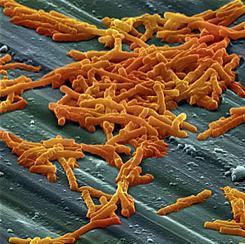Can probiotics reduce the severity of C. difficile infections?

Clostridium difficile spores Copyright : Cjc2nd/Wikimedia
C. difficile is an opportunistic pathogen found in the intestines of approximately 3% of healthy adults and 40% of infants. The bacterium causes a spectrum of diseases in humans, ranging from mild to severe. Infection rates are particularly high in North America and European countries.
Studies have shown that this bacterium is responsible for 10-25% of antibiotic-associated diarrhoea cases, 50-75% of antibiotic-associated colitis cases, and 90-100% of antibiotic-associated pseudomembranous colitis, respectively.
The antibiotics metronidazole and vancomycin have been recommended as the treatments of choice for C. difficile infections since the 1990s. However, there is a high risk that CDI will recur after several days of antibiotic administration. Metronidazole-resistant C. difficile also needs to be considered during treatment.
Thus, a re-evaluation of the use of metronidazole as the first-line treatment is needed in areas with high resistant rates, comment Y. Y. Loong and colleagues.
Probiotics – beneficial microorganisms deliberately introduced into the body – have been used in some patients as an adjunct treatment with some success. However, a detailed investigation on the use of probiotics for infected patients is still needed to determine their real efficacy, recommend the authors. In addition, scientists need to explore new types of probiotics.
“This will enable physicians to choose from a wider range of probiotics and develop a better combination to be used as adjunct treatments.”
For more information about each research, please contact:
Y. Y. Loong
Department of Medicine, Faculty of Medicine and Health Sciences
Universiti Putra Malaysia
43400, Serdang, Selangor, Malaysia
Email: loongyy@yahoo.com
Tel: +(603) 8947 2729; Mobile: +(6) 016 285 2590.
About Pertanika Journal of Science & Technology (JST)
Pertanika Journal of Science & Technology (JST) is published by Universiti Putra Malaysia in English and is open to authors around the world regardless of nationality. Currently, it is published twice a year in January and July. Other Pertanika series include Pertanika Journal of Tropical Agricultural Science (JTAS), and Pertanika Journal of Social Sciences & Humanities (JSSH).
Pertanika Journal of Science & Technology aims to provide a forum for high quality research related to science and engineering research. Areas relevant to the scope of the journal include: bioinformatics, bioscience, biotechnology and bio-molecular sciences, chemistry, computer science, ecology, engineering, engineering design, environmental control and management, mathematics and statistics, medicine and health sciences, nanotechnology, physics, safety and emergency management, and related fields of study.
For more information about the journal, contact:
The Chief Executive Editor (UPM Journals)
Head, Journal Division, UPM Press
Office of the Deputy Vice Chancellor (R&I)
IDEA Tower 2, UPM-MDTC Technology Centre
Universiti Putra Malaysia
43400 Serdang, Selangor
Malaysia.
Phone: +(603) 8947 1622 | +(6016) 217 4050
Email: nayan@upm.my
Acknowledgements
The Chief Executive Editor, UPM Journals
Associated links
- Download the paper from Pertanika Journal of Science and Technology
- Pertanika Journal of Science and Technology
Journal information
Pertanika Journal of Science and Technology
Media Contact
More Information:
http://www.upm.edu.myAll latest news from the category: Life Sciences and Chemistry
Articles and reports from the Life Sciences and chemistry area deal with applied and basic research into modern biology, chemistry and human medicine.
Valuable information can be found on a range of life sciences fields including bacteriology, biochemistry, bionics, bioinformatics, biophysics, biotechnology, genetics, geobotany, human biology, marine biology, microbiology, molecular biology, cellular biology, zoology, bioinorganic chemistry, microchemistry and environmental chemistry.
Newest articles

Security vulnerability in browser interface
… allows computer access via graphics card. Researchers at Graz University of Technology were successful with three different side-channel attacks on graphics cards via the WebGPU browser interface. The attacks…

A closer look at mechanochemistry
Ferdi Schüth and his team at the Max Planck Institut für Kohlenforschung in Mülheim/Germany have been studying the phenomena of mechanochemistry for several years. But what actually happens at the…

Severe Vulnerabilities Discovered in Software to Protect Internet Routing
A research team from the National Research Center for Applied Cybersecurity ATHENE led by Prof. Dr. Haya Schulmann has uncovered 18 vulnerabilities in crucial software components of Resource Public Key…





















